
Shifting gears on a bike is one of the first things to learn as a new rider. Subsequently steering and the brakes, shifting is going to allow you to more than easily and effectively navigate the terrain that yous're riding. Because of the complication of gears and shifting, learning how to shift gears on a bike is not always straightforward and simple. There are a lot of parts on a bike and each ane has a specific task. Knowing how to shift gears on a bike and how the actual shifters work and how to utilize them will make your riding more than functional as well every bit more enjoyable.
The Breakdown
There are six primary components to shifting gears. The first two are the shift levers on both the right and left side of your handle bars. These are then connected with a cable that attaches to the next two of import parts; the derailleurs. There is a front derailleur, which is operated past the left shifter, and a rear derailleur, which is operated by the correct derailleur. The derailleurs shift the chain up or down the forepart chainrings or upwardly and down the rear cassette or cluster of gears. That's basically all there is to propelling the elementary automobile of a bike forwards except that at that place are a number of different types of shifters.
Types of Shifters
The derailleurs, chainrings, and cassettes are more or less the same on about bikes. They volition differ in construction only they still practice the aforementioned basic affair whereas the shifters are operated in a different way across types. Once you know how each one works you lot exist able to easily tell which type of shifters you have so y'all know how to shift gears on a cycle, any wheel.
Lever or Downtube Shifters
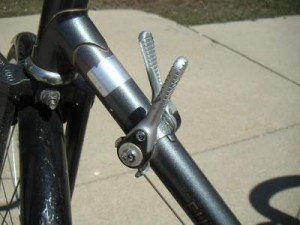
Lever or downtube shifters are the older style of shifters often found on old steel route bikes. The right one shifts the rear derailleur and the left, the front. Pulling the left, or front end, lever backwards tightens the cable and pushes the concatenation up to a bigger front chainring. To shift downwardly, simply push the lever in the opposite direction. To shift the rear derailleur downwards to a harder gear, press the lever up and pull down to shift upwards to an easier gear. Y'all will feel the gears shift as you move the lever so if the gear isn't lined upwards well, you may have to adjust the position of the lever a little to get it to line up perfectly with the gears. Newer and improved downtube shifters are indexed meaning that in that location is a click that corresponds to each gear.
Road Brake Lever Shifters
At present-a-days road bikes take indexed shifting pregnant that there is a click for each gear. Also the shifting is done with the brake lever and/or another paddle that shifts the reverse way. Each of the major three companies making shifters has a bit different approach so here are all three.
Shimano
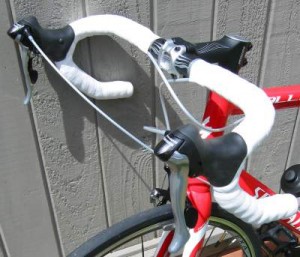
Shimano is 1 of the most widely used road bike shifting mechanisms. They apply two methods to shift. The commencement you will detect on older Shimano shifters as well as lower end ones. These shift past pressing the brake lever inward toward the center of the bike to shift down to a harder gear on the rear cassette while the left, forepart lever shifts the front derailleur upward to a hard gear. To go the opposite direction, there is a small-scale thumb button on the within of hood. Instead of using the thumb push button, newer and higher finish Shimano shifters apply a paddle that is just to the inside of the restriction lever. This is merely pressed inward toward the eye of the bike on its own, ie. not with the brake lever.
SRAM
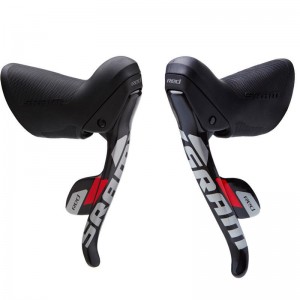
Sram uses every bit similar approach that Shimano does with the inner paddle but instead of having a second button or paddle, this i does it all. For the rear derailleur, press the right paddle (the restriction lever does not move) in almost i centimeter to shift downwards to a harder gear. To shift upward to an easier gear, simply press the paddle farther inward, approximately three centimeters. For the left, front end shifter, shifting slightly in shifts down while making a larger swipe inward shifts your front chainring upwards.
Campagnolo
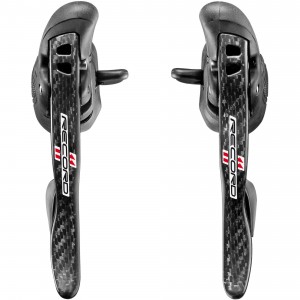
Campy's pattern is similar to that of Shimanos older and lower end shifters as they utilise an inner paddle from the brake lever and a pollex button on the inside of the hood. The difference is that Campy has pretty high end shifters with the like blueprint.
Mountain Thumb Shifters
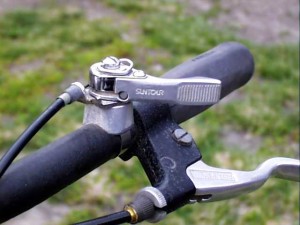
Older fashion mountain bike shifters use a simple lever that is pushed one way to shift up and the other to shift downward. It will depend if you need to shift forrad or dorsum depending on where the shifter is mounted and if it'southward the front or rear shifter. An easy way to effigy out which fashion to become is the for the right, rear shifter information technology will be harder to press in i management while y'all are pedaling. This direction will shift up to and easier gear while shifting in the easier direction will shift downward to a harder gear.
Mountain – Twin Lever Indexed Shifters
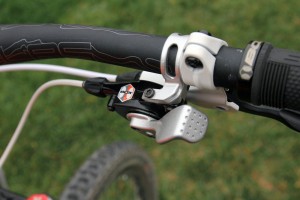
On most modern day mountain bikes you volition find this type of twin lever shifting. There are a few different styles with some having ii levers below the confined while some have ane lever in a higher place and ane below. Typically for the rear shifter, the lower lever shifts up to and easier gear while the upper shifts down to a harder gear. For the front shifter this is reversed.
Twist or Grip-Shifters

Twist grip shifters typically come on many lower level mountain bikes every bit well equally kid'southward bikes. They operate with a uncomplicated twist frontwards or back. Typically in that location will also be numbers displayed showing you which gear you are in. For the right, rear shifter, rotating forward to a larger number shifts downwardly to a harder gear while rotating back toward you lot shifts upward to and easier smaller number. For the left, front shifter, rotating forward shifts down to an easier gear and a smaller number while rotating backwards shifts up to a harder and larger number.
How to Shift Gears on a Bicycle – The Technique of When
Now that you know how to shift gears on a bike, yous need to know when to shift. Typically you lot want to go along a steady pedal stroke that isn't either likewise dull and difficult, nor too easy and fast. Finding the correct gear for what you're comfortable with along with the type of terrain your riding will come with practice. Typically as you ride slower, say up a hill, you lot will shift to the smaller front chain ring with the left shifter while you lot likewise shift up to and easier gear in the dorsum with the right shifter. If you're going faster, say on apartment shine footing or down a hill, you shift the forepart chainring up to a harder gear with the left shifter and shift down to a harder gear in the back with the right shifter.
Learning how to shift gears on a bike is 1 of those things that yous learn when starting to ride and as you ride more, you lot will become good at it. Just make sure to practice in a safe area, say an empty parking lot or driveway, every bit your focus will be on the shifting, not and traffic or other hazards that may be around.

